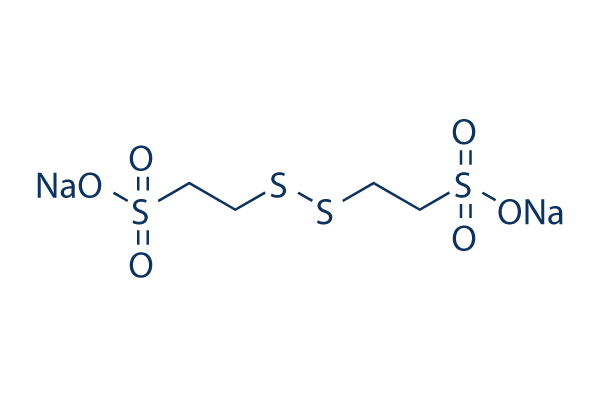|
受注:045-509-1970 |
技術サポート:[email protected] 平日9:00〜18:00 1営業日以内にご連絡を差し上げます |
化学情報

|
Synonyms | BNP-7787 | Storage (From the date of receipt) |
3 years -20°C powder 1 years -80°C in solvent |
|||
| 化学式 | C4H8Na2O6S4 |
||||||
| 分子量 | 326.34 | CAS No. | 16208-51-8 | ||||
| Solubility (25°C)* | 体外 | ||||||
| 体内 (毎回新しく調製した物を用意してください) |
|
||||||
|
* <1 mg/ml means slightly soluble or insoluble. * Please note that Selleck tests the solubility of all compounds in-house, and the actual solubility may differ slightly from published values. This is normal and is due to slight batch-to-batch variations. |
|||||||
生物活性
| 製品説明 | Dimesna (BNP-7787) is an uroprotective agent used to decrease urotoxicity. |
|---|---|
| in vitro | Dimesna modulates paclitaxel-induced hyperpolymerization of MTP in a dose-dependent manner, and mesna, an in vivo metabolite of Dimesna, protects against time-dependent cisplatin-induced inactivation of MTP. [1] Dimesna -mediated prevention or mitigation of cisplatin-induced nephrotoxicity may involve aminopeptidase N (APN) inhibition by certain Dimesna -derived esna-disulfide heteroconjugates and appears correlated to the presence of a glycinate moiety and/or an anionic group. Two general mechanisms for Dimesna -mediated nephroprotection of cisplatin-induced nephrotoxicity involving the gamma-glutamyl transpeptidase (GGT), APN and cysteine-conjugated-β-lyase (CCBL) nephrotoxigenic pathway are proposed which acting in a concerted and/or synergistic manner, and thereby prevent or mitigate cisplatin-induced renal toxicity. [2] Mesna and its dimer, Dimesna, are coadministered for mitigation of ifosfamide- and cisplatin-induced toxicities, respectively. Dimesna is selectively reduced to mesna in the kidney, producing its protective effects. In vitro screens of uptake and efflux transporters reveal renal organic anion transporters OAT1, OAT3, and OAT4 are responsible for kidney-specific uptake of Dimesna. Uptake of Dimesna by OAT1, OAT3, and OAT4 is determined to be saturable with KM of 636 μM, 390 μM and 590 μM, respectively. [3] |
| in vivo | Tumors of urinary bladder induced by cyclophosphamide (CP) in rats can be significantly reduced by Dimesna administration in a dose-related manner. [4] |
プロトコル(参考用のみ)
| キナーゼアッセイ | Fluorometric APN Assay | |
|---|---|---|
| The activity of human APN is determined based on enzyme-specific fluorometric biochemical assays described as follows. The assay monitored the release of fluorescent product, free AMC, that is liberated when human APN cleaves Leu-AMC. Reaction conditions described herein used a vast excess of Leu-AMC (100 μM/ assay) in comparison with APN enzyme (~1.9 nM/assay or ~20 ng/assay) in each assay. The initial velocity in reactions is determined during the linear phase of the assay when substrate concentration is saturating (for each experiment calculating the rate of the reaction during the 2–8 minutes range of the assay). Additionally, the progress curve of the assays is monitored for at least 30 minutes. These assays are run in replicates of 6–8 per plate per test article concentration. For each test article, all assays are conducted on at least 2 different days to ensure reproducibility and quality of the data. Master mixes (75 μL total volume) containing substrate, test article and buffer are aliquoted to wells and plates are equilibrated to 37 °C for 5 minutes inside the Xuorimeter. It should be noted that deviations in plate equilibration can lead to lags that are reflected in nonlinear behavior during the initial portion of the enzyme progress curve. Next, twenty-five microliters (25 μL) of diluted human APN (8 × 104 μg/μL made by diluting 2 μL of 10 μg APN stock from R&D Systems with 1.47 mL of buffer) is added to individual wells to initiate the reaction (no enzyme controls are “initiated” with 25 μL of buffer only) and after addition of APN to equilibrated plates, plates are agitated in the Xuorimeter for 10 seconds prior to the first read. Buffer background control, enzyme only negative control, substrate autohydrolysis control, product only control (AMC) and enzyme activity positive control are also performed. Experiments where assays are initiated with Leu-AMC instead of APN are also conducted for several test articles and give essentially identical results to the assays initiated with APN. | ||
| 動物実験 | 動物モデル | CP treated Sprague-Dawley rats |
| 投薬量 | 12 or 35 mg/kg | |
| 投与方法 | Orally five times a week | |
参考
長期の保管のために-20°Cの下で製品を保ってください。
人間や獣医の診断であるか治療的な使用のためにでない。
各々の製品のための特定の保管と取扱い情報は、製品データシートの上で示されます。大部分のSelleck製品は、推薦された状況の下で安定です。製品は、推薦された保管温度と異なる温度で、時々出荷されます。長期の保管のために必要とされてそれと異なる温度で、多くの製品は、短期もので安定です。品質を維持するが、夜通しの積荷のために最も経済的な貯蔵状況を用いてあなたの送料を保存する状況の下に、製品が出荷されることを、我々は確実とします。製品の受領と同時に、製品データシートの上で貯蔵推薦に従ってください。
